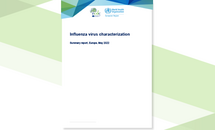Influenza virus characterisation - Summary Europe, February 2021
ECDC’s influenza virus characterisation reports are published periodically and give an overview of circulating influenza viruses. They provide details on the current vaccine strains, summarise the development of the viruses since the last report, and closely follow the main developments for the ongoing influenza season. Virus characterisation reports are primarily intended for influenza virologists and epidemiologists.
Executive Summary
This is the fourth report for the 2020-2021 influenza season. As of week 8/2021, only 712 influenza detections across the WHO European Region had been reported to TESSy; 51% type A viruses, with A(H3N2) and A(H1N1)pdm09 being equally represented, and 49% type B viruses, with only 10 having been ascribed to a lineage, eight B/Victoria and two B/Yamagata. This represents a 99.5% drop in detections compared to the same period in 2020, probably due to the COVID-19 pandemic and measures introduced to combat it.
Since the December 2020 characterisation report1, six shipments from European Union/European Economic Area (EU/EEA) countries, containing a total of 20 influenza-positive specimens, have been received at the London WHO Collaborating Centre, the Francis Crick Worldwide Influenza Centre (WIC). This report therefore focuses mainly on genetic characterisation of the HA genes of influenza viruses with the most recent collection dates (after 31 August 2020) based on sequences deposited in GISAID up to 28 February 2021.
Of the 27 A(H1N1)pdm09 HA sequences in GISAID for viruses collected after 31 August 2020, two from the United States of America (US) fell in the 6B.1A5B group; one from Ghana fell in the basal 6B.1A5A group; two, one each from China and Ghana, fell in the 6B.1A5A+156K subgroup represented by A/Victoria/2570/2019, the vaccine virus for the southern hemisphere 2021 and northern hemisphere 2021-2022 seasons; and 22, two from Japan, three from Ghana and 17 from Togo, fell in the 6B.1A5A+187V/A subgroup represented by A/Guangdong-Maonan/SWL1536/2019, the vaccine virus for the northern hemisphere 2021-2022 season. The 20 viruses from West Africa in the 6B.1A5A+187V/A subgroup all contained additional HA1 amino acid substitutions of I166T and A186T.
Of the 162 A(H3N2) HA sequences in GISAID for viruses collected after 31 August 2020, one fell in the 3C.2a1b+T135K-B subgroup represented by A/Hong Kong/2671/2019, the vaccine virus for the northern hemisphere 2021-2022 and southern hemisphere 2021 seasons; 24, one from France and 23 from West Africa fell in the 3C.2a1b+T135K-a subgroup represented by the reference virus A/Denmark/3264/2019; and 137 fell in the 3C.2a1b+T131K-A subgroup. The viruses in the 3C.2a1b+T135K-A subgroup formed two clusters: the first contained 96 viruses, 84 being from Bangladesh, with HA1 amino acid substitutions of Y159N, T160I (loss of a glycosylation site), L164Q, G186D, D190N, F193S and Y195F; and the second contained 40 viruses, 22 being from Cambodia, with HA1 amino acid substitutions of G186S, F193S, Y195F and S198P, with 39 HAs also having K171N. Viruses in these two clusters were antigenically distinct from one another, and from those in other A(H3N2) genetic groups, and A/Cambodia/e0826360/2020 was recommended as the vaccine virus for the northern hemisphere 2021-2022 influenza season.
Download








